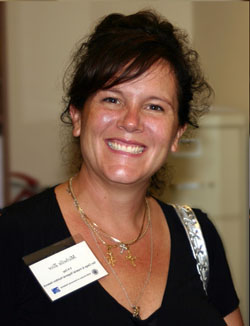To get a healthy variety, think in color! Do you know what are the colors of health? Spring Into Health: Eating through the Rainbow!
by Michelle Murphy Zive, M.S., R.D.
There’s no better time than now to get healthy by eating the abundance of fresh fruits and vegetables that are available as the weather turns warmer. And did you know that the more color a fruit or vegetable has, the more vitamins it contains? By eating a variety of fruits and vegetables of all different colors, you can ensure that you and your children are getting many nutrients to be the healthiest you can be.
Fruits and vegetables can be divided into the colors of the rainbow: red, yellow/orange, green, blue/purple, and white. Each color group is rich in specific nutrients, especially phytochemicals. Phytochemicals are found in plant foods and are linked to lower rates of cancer, heart disease and other diseases. The Produce for Better Health Organization has created a list of health benefits of each color and the produce that belongs in each of the color groups.
In the past, it was recommended that you eat five fruits and vegetables a day. Ever heard of the 5 a Day campaign? The campaign has simplified what a serving of fruit or vegetable is by measuring servings in cups. The 5 a Day program now recommends that adults eat 4 to 6.5 cups per day and children eat 3 to 5 cups a day, depending on sex, age and activity level. But what is a cup? A small apple is a cup and 15 baby carrots equal a cup. To find out exactly how many fruits and vegetables go to www.mypyramid.gov.For more information about eating fruits and vegetables, log onto www.sdnnonline.org. The San Diego and Imperial Regional Nutrition Network is funded by the U.S. Department of Agriculture Food Stamp Program. An equal opportunity provider and employer, through the California Nutrition Network Healthy, Active Families. For information about the California Food Stamp Program, please call 1-800-952-5253 Funded in part, by the U.S. Department of Agriculture Food Stamp Program. An equal opportunity provide and employer, through the California Nutrition Network. For information about the California Food Stamp Program, please call 1-800-952-5253 Michelle Murphy Zive, M.S., R.D. is a registered dietitian with the Regional Nutrition Network and 5 a Day campaigns and the mother of three. |
||
Salud + Health Info is for information and educational purposes only. You should not rely on this information as a substitute for personal medical attention, diagnosis or hands-on treatment. If you are concerned abut your health or that of a child, please consult your family’s physician or health provider immediately and do not try to diagnose yourself. Copyright © 2001-2006 Info Option Network |
Bienvenido a la primer revista dedicada al cuidado de la salud
 info
info
The first, the best & the only English & Spanish Magazine in San Diego, California
If you are pregnant, breasfeeding or have a children under 5
|
|
|
|
|
|
|
|
|
|
|
|
|
|
|
|
|
|
|
|
|
|
| FACT SHEETS available for download on pdf files. | |
|
|
|
|
• •
•
• •
•
• •
•
|
|
• •
•
• •
•
|
|





 carotene. Foods in this group include yellow apples, apricots, cantaloupe, grapefruit, lemon, mangoes, nectarines, oranges, papayas, peaches, yellow pears, persimmons, pineapples, tangerines, carrots, yellow peppers, yellow potatoes, pumpkin, yellow squash, sweet corn, sweet potatoes and yellow tomatoes.
carotene. Foods in this group include yellow apples, apricots, cantaloupe, grapefruit, lemon, mangoes, nectarines, oranges, papayas, peaches, yellow pears, persimmons, pineapples, tangerines, carrots, yellow peppers, yellow potatoes, pumpkin, yellow squash, sweet corn, sweet potatoes and yellow tomatoes.